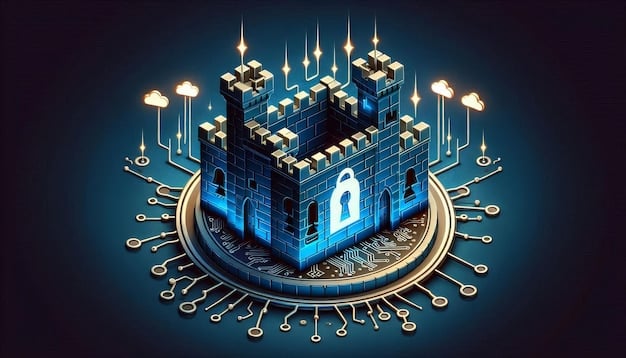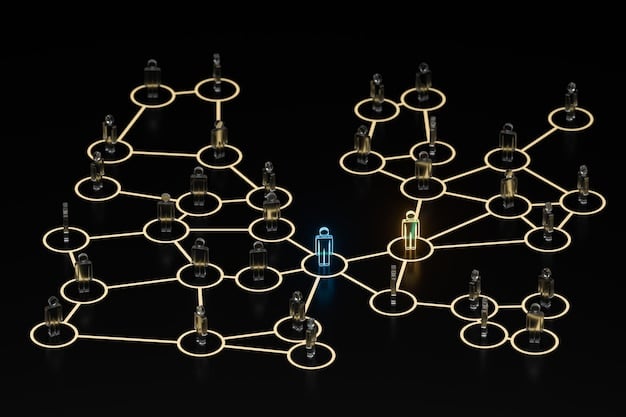Cybersecurity Guide 2025: Zero Trust in 90 Days

Cybersecurity Guide 2025: Implement Zero Trust Architecture in 90 Days provides a practical roadmap for organizations to adopt a Zero Trust framework, enhancing security posture and mitigating risks in a rapidly evolving threat landscape, within a structured 90-day plan.
Embark on a transformative journey to fortify your organization’s defenses with the Cybersecurity Guide 2025: Implement Zero Trust Architecture in 90 Days. This guide is designed to provide a clear, actionable path to implementing a Zero Trust framework, ensuring your systems are secure against modern cyber threats.
Understanding Zero Trust Architecture
Zero Trust Architecture (ZTA) is a security framework based on the principle of “never trust, always verify.” Unlike traditional security models that assume trust within a network, ZTA requires every user and device to be authenticated and authorized before accessing any resource. This approach significantly reduces the attack surface and minimizes the impact of potential breaches.
Adopting ZTA involves several key components, including microsegmentation, multi-factor authentication (MFA), and continuous monitoring. These elements work together to create a robust security posture that adapts to the ever-changing threat landscape.
Key Principles of Zero Trust
Implementing Zero Trust requires a shift in mindset and security practices. Here are the foundational principles that guide the adoption of ZTA:
- Assume Breach: Always operate as if a breach has already occurred. This mindset drives proactive security measures.
- Explicit Verification: Continuously authenticate and authorize every user and device before granting access.
- Least Privilege Access: Grant only the minimum level of access necessary to perform a task.
- Microsegmentation: Divide the network into small, isolated segments to limit the blast radius of a breach.

By adhering to these principles, organizations can build a more resilient and secure environment, effectively mitigating the risks associated with modern cyber threats. Zero Trust is not a product but a security strategy that requires continuous adaptation and improvement.
Phase 1: Assessment and Planning (Weeks 1-3)
The first phase of implementing Zero Trust involves a comprehensive assessment of the current security posture and meticulous planning for the transition. This phase sets the foundation for a successful and efficient implementation process. It’s crucial to understand the existing infrastructure, identify vulnerabilities, and define clear objectives.
During these initial weeks, focus on gathering data, analyzing risks, and creating a detailed roadmap that aligns with the organization’s specific needs and goals.
Conduct a Security Audit
Begin with a thorough security audit to identify existing vulnerabilities and gaps in the current security framework. This audit should cover all aspects of the IT infrastructure, including network devices, servers, applications, and endpoints.
- Network Vulnerability Scanning: Identify open ports, misconfigurations, and outdated software.
- Application Security Testing: Evaluate applications for vulnerabilities such as SQL injection and cross-site scripting.
- Endpoint Assessment: Ensure all devices are properly configured, patched, and protected with endpoint detection and response (EDR) solutions.
By conducting a comprehensive security audit, organizations can gain a clear understanding of their current security posture and identify areas that require immediate attention.
Phase 2: Identity and Access Management (Weeks 4-6)
Identity and Access Management (IAM) is a cornerstone of Zero Trust Architecture. This phase focuses on implementing robust authentication and authorization mechanisms to ensure only verified users and devices gain access to resources. Strengthening IAM is essential for enforcing the “never trust, always verify” principle.
Implementing Multi-Factor Authentication (MFA) and defining granular access policies are key steps in this phase. These measures significantly reduce the risk of unauthorized access and lateral movement within the network.
Implement Multi-Factor Authentication (MFA)
MFA adds an additional layer of security by requiring users to provide multiple forms of verification before granting access. This makes it significantly more difficult for attackers to compromise accounts, even if they obtain passwords.
- Choose Appropriate MFA Methods: Consider factors such as user convenience, security, and cost when selecting MFA methods.
- Enforce MFA for All Users: Ensure MFA is enabled for all users, including administrators and privileged accounts.
- Regularly Review and Update MFA Policies: Stay informed about emerging threats and adjust MFA policies accordingly.
MFA should be a standard practice for all organizations seeking to enhance their security posture and mitigate the risk of credential-based attacks.
Phase 3: Network Microsegmentation (Weeks 7-9)
Network microsegmentation involves dividing the network into smaller, isolated segments, each with its own security controls and policies. This approach limits the blast radius of a breach, preventing attackers from moving laterally within the network and accessing sensitive resources.
Implementing microsegmentation requires careful planning and execution, but the benefits in terms of enhanced security and reduced risk are significant. It’s a critical component of Zero Trust Architecture.
Define Network Segments
Identify critical assets and group them into logical segments based on their function, risk level, and access requirements. This process helps define the boundaries for each segment and the security policies that will be applied.
Carefully defining segments is key. Some areas demand greater security:
- Critical Data Servers: Servers that store sensitive data should be placed in a highly protected segment.
- Development Environments: Isolate development environments to prevent vulnerabilities from affecting production systems.
- IoT Devices: Segment IoT devices to limit their access to the rest of the network and reduce the risk of compromise.
Well-defined network segments are crucial for enforcing granular security policies and preventing unauthorized access to critical resources.
Phase 4: Continuous Monitoring and Threat Detection (Weeks 10-12)
Continuous monitoring and threat detection are essential for maintaining a robust security posture and responding to emerging threats in real-time. This phase focuses on implementing tools and processes to monitor network activity, detect anomalies, and respond to incidents effectively. A proactive approach is a key strategy to reducing risk over time.
Implementing Security Information and Event Management (SIEM) systems, Endpoint Detection and Response (EDR) solutions, and threat intelligence feeds are critical steps in this phase.
Implement SIEM and EDR Solutions
SIEM and EDR solutions provide comprehensive visibility into network activity and endpoint behavior, enabling organizations to detect and respond to threats quickly. These solutions collect and analyze data from various sources, identifying suspicious patterns and alerting security teams to potential incidents.
Consider the following capabilities:
- Real-Time Monitoring: Continuously monitor network traffic, system logs, and user activity for signs of compromise.
- Automated Threat Response: Automate incident response processes to contain and mitigate threats quickly.
- Threat Intelligence Integration: Incorporate threat intelligence feeds to stay informed about emerging threats and improve detection capabilities.

Implementing SIEM and EDR solutions is a crucial step in maintaining a proactive security posture and responding effectively to cyber threats.
Phase 5: Automation and Orchestration (Weeks 13-90)
Automation and orchestration are key to streamlining security operations and improving efficiency. This phase focuses on automating repetitive tasks, orchestrating security workflows, and integrating security tools to work together seamlessly. This can include workflow automation as well as scripting tasks to automate repetitive workflows and mundane tasks.
Implementing Security Orchestration, Automation, and Response (SOAR) platforms and automating incident response processes are critical steps in this phase.
Automate Incident Response
Automating incident response streamlines the process of detecting, investigating, and responding to security incidents. This reduces the time it takes to contain and mitigate threats, minimizing the impact on the organization.
Some areas to consider are:
- Automated Threat Detection: Use machine learning algorithms to identify suspicious patterns and trigger automated alerts.
- Automated Containment: Automatically isolate compromised systems to prevent the spread of malware.
- Automated Remediation: Automatically remove malware, reset passwords, and restore systems to a secure state.
Automated incident response helps organizations respond to threats quickly and efficiently, reducing the risk of data breaches and other security incidents.
Maintaining Zero Trust Architecture
Once Zero Trust Architecture is implemented, it’s crucial to maintain and continuously improve the security framework. This involves regularly reviewing and updating security policies, conducting penetration testing, and staying informed about emerging threats. Always be improving, and actively engaging in the IT and Cybersecurity community.
Continuous improvement ensures that the security posture remains strong and adaptable to the ever-changing threat landscape.
| Key Area | Brief Description |
|---|---|
| 🛡️ Assessment & Planning | Evaluate current security and plan ZTA implementation. |
| 🔑 Identity Management | Implement MFA and granular access policies. |
| 🌐 Network Microsegmentation | Divide network into isolated segments. |
| 🚨 Continuous Monitoring | Monitor network and automate incident response. |
FAQ
▼
Zero Trust Architecture (ZTA) is a security framework based on the principle of “never trust, always verify.” It requires every user and device to be authenticated and authorized before accessing any resource.
▼
Implementing Zero Trust enhances your security posture by reducing the attack surface, minimizing the impact of breaches, and adapting to the evolving threat landscape, ensuring better protection.
▼
With a structured approach, it is possible to begin implementation within 90 days. This involves assessment, planning, identity management, microsegmentation, and continuous monitoring, phased effectively.
▼
Key components include microsegmentation, multi-factor authentication (MFA), continuous monitoring, and least privilege access, ensuring comprehensive security coverage across the network.
▼
Automation streamlines security operations by automating repetitive tasks, orchestrating security workflows, and integrating security tools, improving efficiency and reducing response times to security incidents.
Conclusion
Implementing Zero Trust Architecture is a critical step for organizations looking to enhance their security posture and protect against modern cyber threats. By following this 90-day guide, organizations can establish a strong foundation for Zero Trust and continuously improve their security defenses.





